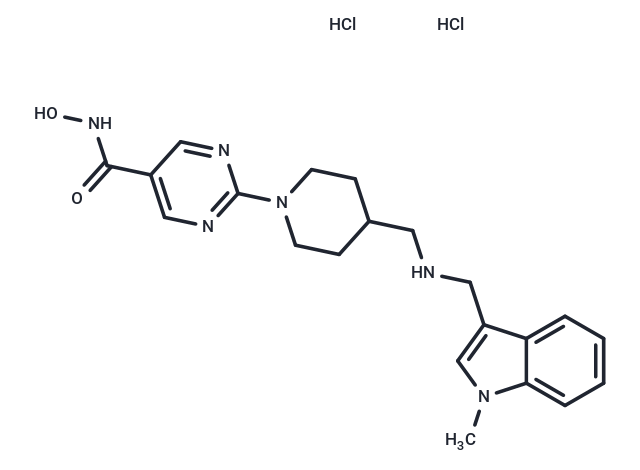Shopping Cart
- Remove All
 Your shopping cart is currently empty
Your shopping cart is currently empty

Quisinostat dihydrochloride (JNJ26854165(Quisinostat) 2HCl) is a novel second-generation HDAC inhibitor with highest potency for HDAC1 with IC50 of 0.11 nM in a cell-free assay, modest potent to HDACs 2, 4, 10, and 11; greater than 30-fold selectivity against HDACs 3, 5, 8, and 9 and lowest potency to HDACs 6 and 7. Phase 2.

| Pack Size | Price | Availability | Quantity |
|---|---|---|---|
| 1 mg | $59 | In Stock | |
| 5 mg | $129 | In Stock | |
| 10 mg | $227 | In Stock | |
| 25 mg | $349 | In Stock | |
| 50 mg | $457 | In Stock | |
| 100 mg | $659 | In Stock | |
| 1 mL x 10 mM (in DMSO) | $132 | In Stock |
| Description | Quisinostat dihydrochloride (JNJ26854165(Quisinostat) 2HCl) is a novel second-generation HDAC inhibitor with highest potency for HDAC1 with IC50 of 0.11 nM in a cell-free assay, modest potent to HDACs 2, 4, 10, and 11; greater than 30-fold selectivity against HDACs 3, 5, 8, and 9 and lowest potency to HDACs 6 and 7. Phase 2. |
| Targets&IC50 | HDAC1:0.11 nM |
| In vitro | Quisinostat exhibits broad spectrum antiproliferative activity in solid and hematologic cancer cell lines, such as all lung, breast, colon, prostate, brain, and ovarian tumor cell lines, with IC50 ranging from 3.1-246 nM, which is more potent than vorinostat, R306465, panobinostat, CRA-24781, or mocetinostat in various human cancer cell lines tested. [1] A recent study shows that Quisinostat promotes myeloma cell death at low nanomolar concentrations by resulting in Mcl-1 depletion and Hsp72 induction. [2] |
| In vivo | In an HDAC1-responsive A2780 ovarian tumor screening model, Quisinostat dosing at its maximal tolerated dose (10 mg/kg i.p. and 40 mg/kg p.o.) for 3 days leads to an HDAC1-regulated fluorescence , which predicts tumor growth inhibition. Furthermore, Quisinostat also shows more potent inhibitory effects on the growth of C170HM2 colorectal liver metastases than 5-fluorouracil/Leucovorin. [1] |
| Kinase Assay | HDAC activity assays : In all cases, full-length HDAC proteins are expressed using baculovirus-infected Sf9 cells. In addition, HDAC3 is coexpressed as a complex with human NCOR2. For assessing activity of HDAC1-containing cellular complexes, immunoprecipitated HDAC1 complexes are incubated with an [3H]acetyl- labeled fragment of histone H4 peptide [biotin-(6-aminohexanoic)Gly-Ala-(acetyl[3H])Lys-Arg-His-Arg-Lys-Val-NH2] in a total volume of 50μL enzyme assay buffer (25 mM HEPES (pH 7.4), 1 M sucrose, 0.1 mg/mL BSA and 0.01% (v/v) Triton X-100). Incubation is performed for 45 minutes at 37 °C (immunoprecipitates) or 30 min at room temperature. Before addition of substrate, HDAC inhibitors are added at increasing concentrations and preincubated for 10 minutes at room temperature. After incubation, the reaction is quenched with 35μL stop buffer (1 M HCl and 0.4 M acetic acid). Released [3H]acetic acid is extracted with 800μL ethyl acetate and quantified by scintillation counting. Equal amounts of HDAC1 are immunoprecipitated as indicated by Western blot analysis. HDAC1 activity results are presented as mean ± SD of three independent experiments on a single lysate. |
| Cell Research | All cell lines are obtained from American Type Culture Collection and cultured according to instructions. The effect of HDAC inhibitors on cell proliferation is measured using an MTT. Proliferation of non–small cell lung carcinoma (NSCLC) cell lines is assessed using an Alamar Blue–based assay. For proliferation of hematologic cell lines, cells are incubated for 72 hours and the cytotoxic activity is evaluated by MTS assay. Data are presented as mean IC50 or IC40 ± SD of at least three independent experiments.(Only for Reference) |
| Alias | Quisinostat 2HCl, Quisinostat (JNJ-26481585) 2HCl, JNJ26854165(Quisinostat) 2HCl, JNJ-26481585 2HCl |
| Molecular Weight | 467.39 |
| Formula | C21H28Cl2N6O2 |
| Cas No. | 875320-31-3 |
| Smiles | Cl.Cl.Cn1cc(CNCC2CCN(CC2)c2ncc(cn2)C(=O)NO)c2ccccc12 |
| Relative Density. | no data available |
| Storage | Powder: -20°C for 3 years | In solvent: -80°C for 1 year | Shipping with blue ice. | |||||||||||||||||||||||||||||||||||
| Solubility Information | DMSO: 73 mg/mL (156.19 mM), Sonication is recommended. Ethanol: < 1 mg/mL (insoluble or slightly soluble) H2O: < 1 mg/mL (insoluble or slightly soluble) | |||||||||||||||||||||||||||||||||||
Solution Preparation Table | ||||||||||||||||||||||||||||||||||||
DMSO
| ||||||||||||||||||||||||||||||||||||

Copyright © 2015-2025 TargetMol Chemicals Inc. All Rights Reserved.